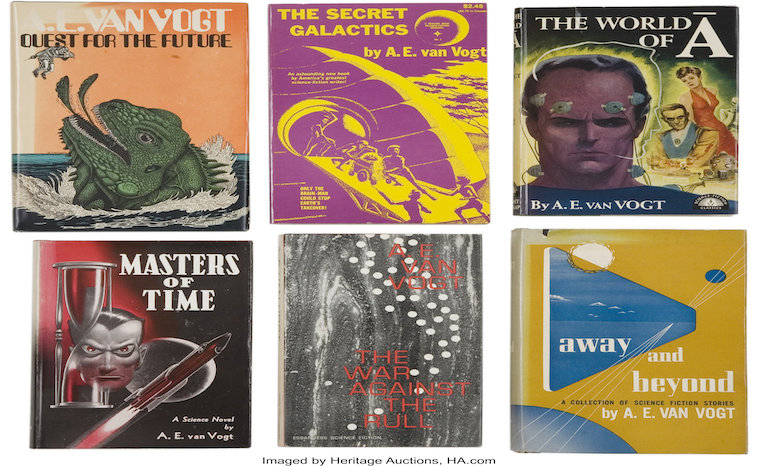A.E. van Vogt Science Fiction Writer

A.E. van Vogt was a popular science fiction writer during the Golden Age of the science fiction genre. Read on to learn more about this amazing writer.
Alfred Elton van Vogt began his writing career in his early twenties. Born in 1912, under the name Alfred Vogt, he later added the Elton and van. He then shortened his name for his stories to A.E. van Vogt. He got his start writing for True Confessions magazine under a pen name as a female. Many of the stories for that magazine focused on stories by women concerning relationships and turmoil. By 1938, Alfred decided to start writing science fiction. The first Golden Age of Science Fiction was underway, and Alfred saw his opportunity.
A.E. van Vogt Early Years
The “Black Destroyer” was published in July 1939 by John W. Campbell in Astounding Science Fiction. It featured a fierce, carnivorous alien, the coeurl, stalking the crew of an exploration spaceship. This story served as the inspiration for multiple science fiction movies, including Alien (1979). When the film appeared, van Vogt realized the plot matched his two stories, Black Destroyer and Discord in Scarlet. Astounding magazine published these stories in 1939. As a result, Van Vogt sued the production company for plagiarism. He won his case and collected an out-of-court settlement of $50,000 from 20th Century Fox.
Van Vogt’s first completed novel, and one of his most famous, is Slan. It told the story of a nine-year-old superman living in a world in which people slay his kind. His early years of writing, between 1941 through 1944, featured short stories.
Writing Style and Method
He stated that he acquired many of his writing techniques from three books.
- Narrative Technique by Thomas Uzzell
- The Only Two Ways to Write a Story by John Gallishaw
- Twenty Problems of the Fiction Writer by Gallishaw.
However, Alfred claimed many of his ideas came from dreams. He used a unique method to capture his dreams. A special timer routinely went off every 90 minutes. A tape recorder then turned on and captured his thoughts from those dreams.
Writer Charles Platt describes Vogt this way, ” Of course, many fantasists pursue their imaginations oblivious to the reality around them. But this is especially true of van Vogt. First, because he works more intimately with his subconscious than most writers. Second, because much of his life has been spent looking inward, studying psychology and human behavior, primarily through Dianetics and hypnosis.”
“And so van Vogt derived his inspiration through his sleep, filling his science-fiction adventures with fantastic images, symbolic figures, a constant sense of discovery and revelation, and free, flying motion (aided by those telegraphic 800-word scenes, which enforced a fast pace).
However, during the 1950s, van Vogt changed his writing style. In a method he called “fix-ups,” he added material to previously written stories. These “fix-ups” helped him continue his writing career for 10 more years.

Professioanl Criticism
A.E. van Vogt did not write without criticism. Damon Knight, a well-known critic, wrote. “no giant; he is a pygmy who has learned to operate an overgrown typewriter.”
However, fellow science fiction writer Phillip K. Dick defended A.E. van Vogt. When asked which science fiction writers had influenced his work the most, he replied:
“I started reading [science fiction] when I was about twelve and I read all I could, so any author who was writing about that time, I read. But there’s no doubt who got me off originally and that was A. E. van Vogt. There was in van Vogt’s writing a mysterious quality, and this was especially true in The World of Null-A. All the parts of that book did not add up; all the ingredients did not make a coherency. Now some people are put off by that. They think that’s sloppy and wrong, but the thing that fascinated me so much was that this resembled reality more than anybody else’s writing inside or outside science fiction.”
From 1963 through the mid-1980s, van Vogt published new material regularly, though fix-ups and reworked material also appeared relatively often.
On January 26, 2000, A. E. van Vogt died in Los Angeles from Alzheimer’s disease.
